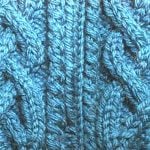
The Aran Sweater is named after the set of islands off Ireland's West coast where it was first created many generations ago. The Aran Islands are located at the mouth of Galway Bay on the Atlantic Sea and are where fishermen and farmers dwelled and worked together.
The traditional Irish Aran sweater was fashioned in this environment and has since been passed down through generations to be considered the ultimate Irish Clan Heritage symbol. It is still very popular today in many knitting circles and is also worn by those who appreciate its origin and symbolism.
ORIGIN OF THE ARAN SWEATER

Aran sweaters are highly sought-after, and still, make quite a fashion statement many years after their creation. Back in the 1950s on the Aran Islands, many of the men were fishermen by trade and, out of necessity to combat the cold and tough conditions of the sea, the women handmade their husbands Aran sweaters to keep them warm, hence the name fisherman sweaters we're all familiar with today.
Due to their popularity with the local Irish fishermen, they were also sold on the island which helped provide a living for some of the families, and a booming new grassroots economy was born.
The intricate cables, bobbles and stitch patterns make these garments popular for a number of reasons. They are challenging to knit, lend aesthetic appeal to the apparel, and add warmth and thickness. Back then, hand-knitting an Aran sweater took between 3 to 6 weeks to complete.
The origin of the Aran sweater can be traced back to Guernsey, an island 400 miles South-East of the Aran Islands. Much of Guernseys trade relied on fishing, and the clothing requirements of fishermen were quite demanding.
A sea-faring laborer's clothes needed to be durable, easy to mend, stain resistant, easy to move about in, be able to provide warmth to the wearer, and if possible, keep out water. Thus, the gansa sweater.
The Gansa (aka 'gansai) was a simple design, allowing for free movement. Its dark navy color was stain-resistant to a number of liquids, and the knitting was tight to keep the wearer dry. Over time, the stitches became more complicated.
As the popularity of the Gansa grew, knitters further developed the stitching, with noticeable differences seen in Ireland and Scotland. Various types of cable stitches were used: diamond lattices, plates, ropes, and the Celtic Knot design.
Before long the stitch patterns covered the entire sweater, creating an even more aesthetically pleasing garment. Before long, commercial interest took hold, and the aran sweater began to really grow in popularity.
As it evolved, the modern Aran sweater was manufactured with thicker yarn, the sweaters were knitted flat and seam is sewn together, and the stitching became looser. This decreased the amount of time it took to knit a sweater, thus increasing the Aran's production output.
The Aran sweater is known for its stitching patterns and intricacies and is considered both a practical choice and fashion statement.
ARAN SWEATER MYTHS
A myth about the Aran sweater is that the stitches are linked to family names the legend has it that each stitch represents a family second name so that is the fisherman was lost at sea the family would be able to identify the body by the stitch on the sweater although an interesting story, it has not been proven at a fact! While Aran sweaters were indeed knit to keep the fisherman warm and cosy at sea, the idea of each stitch is a family name is, unfortunately, a myth.
Due to the expanding population of the Aran Islands at the time, the government introduced a board called 'The Congested Districts Board' as a way to come up with ideas of improving the standard of living on the island. The put a lot of effort into farming and fishing and knitting for the ladies.
The people of the Aran Islands decided to bring over some Scottish fishermen to teach the Islanders a few things, they also brought some Scottish ladies who showed how to knit sweaters for a living. So the Irish ladies took their idea and made it their own - the yarn they used in Ireland was much thicker than the fine Scottish wool and the design had lots more patterns to it, rather than just the top which the Scottish version had.
By 1935, these sweaters were so in demand they started selling them in the Dublin markets!
ARAN SWEATER STITCHES AND THEIR MEANINGS
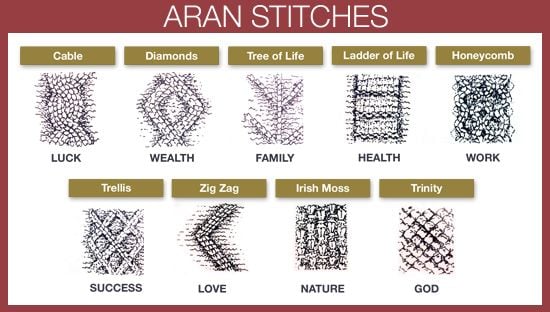
Aran knitting stitches are beautiful, complicated, and represent the lives of the fishermen who wore them. They must be hand-knitted, are believed to have been symbolic of nature, the sea, and the fishing families who lived on the Aran Islands. The patterns on Aran sweaters are based on Irish Tradition each stitch represents a different meaning and symbolizes something of importance. Here are some of the most popular stitches and their meanings. We have a large range of aran cardigans and Irish sweaters featuring an array of Irish stitches in each style.
THE BASKET STITCH

This stitch represents the basket the fisherman used, and his hope of filling it with his catches.
BLACKBERRY STITCH

This is symbolic of the rich abundance of nature, and may also possess religious implications.
CABLE STITCH

This is, perhaps, the most frequent stitch found on Irish sweaters, and comes in different forms. The plain cable illustrates the ropes of Irish fisherman, promising good luck and safety at sea. A plated stitch illustrates how daily life and hard work are woven together. The cable stitch is showed beautifully on one of our best-selling Irish sweaters - the traditional Irish Aran sweater in stunning pink!
TREE OF LIFE OR TRINITY STITCH

This stitch is said to promise a long life and strong children. Religious connotations are also thought to be represented.
TRELLIS STITCH
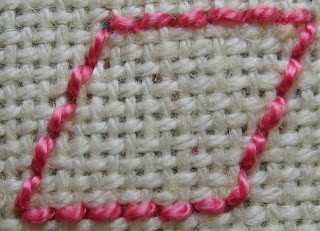
This stitch is symbolic of the landscape patterns of fenced-in fields accompanied by roughly hewn stones that protect inhabitants from strong winds on the island.
IRISH MOSS STITCH

This is often used as a diamond filler and suggests a respectable harvest. It symbolizes carrageen moss, which is a type of seaweed on the Irish coast that is used as both food and fertilizer of barren fields.
HONEYCOMB STITCH
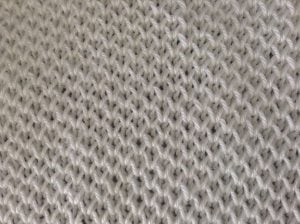
This stitch is a reminder of the bee who works hard and assures a reward for labour.
DIAMOND STITCH
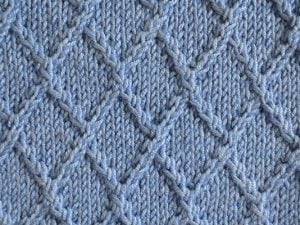
This stitch symbolizes the shapes of mesh fishing net, and also stands for success and wealth.
ZIG ZAG STITCH

This stitch represents the ups and downs that married couples face.
TYPES OF ARAN SWEATERS
When selecting an Aran sweater, there are many different sweater types from which to choose. Some of the most popular include the following:
WOMENS CABLE KNIT

This style is crafted from soft, Merino wool with the cable knit design. This traditional stitch is quite popular because it represents the culture from which it came.
HANDKNIT CREW NECK
Also made of soft Merino wool, this hand knit sweater for women and men also features the cable stitch, and has a crew neckline.
UNISEX ARAN
This option is constructed of different types of Irish stitching, starting with the honeycomb around the centre, with cable stitching on either side. Check out our classic unisex aran fisherman sweater.
SHAWL NECK

The shawl neck Aran sweater features delicate Aran stitching with a shawl neck. It works well for both daytimes casual or nighttime dressing up.
WOOL AND CASHMERE TRELLIS

This Aran wool and trellis stitched sweater is 95% Merino wool and 5% cashmere and is a soft, comfortable option.
TURTLENECK

The turtleneck Aran sweater features Aran stitching and a turtleneck for added warmth.
DENIM MARL
Featuring Aran stitching, this sweater is 100% Merino wool, and is warm, soft and stylish to wear.
THE EVOLUTION OF THE IRISH SWEATER
Generations after its creation, the Aran sweater is still going strong. Recently the Aran sweater made the list of iconic fashion pieces featured in an exhibition in Manhattan's Museum of Modern Art. Chosen because of its impact on the world during the last century, it has remained popular in the entertainment industry and fashion world alike.
The National Museum of Ireland loaned one of its oldest sweaters for the exhibition, where it was placed beside other fashion elites such as the Birkin Bag, Wonderbra, a pair of Levis 501 jeans dating back to the 1940s, and an assortment of little black dresses.
FAMOUS PEOPLE WEARING ARAN SWEATERS

The patterns of our famous Irish Aran Sweater made it into Vogue in 1956 and like that, its popularity went from strength to strength.
In the 1950s, Vogue magazine published articles on the sweater, Marilyn Monroe was a fan! Aran sweater exports from the west of Ireland to the United States began.
The development of the export trade during the 50s and 60s saw knitting become an important part of the islands' economy.
1960s
Irish Folk music group, The Clancy Brothers and Ted Maken, adopted the Aran Sweater as their trademark on-stage garment. In the early 60s they appeared on The Ed Sullivan Show and in a special televised performance for US President John F Kennedy, wearing Aran Sweaters.

They made Aran sweaters cool in the States and brought it back to life in Ireland!! The Irish folk band were over in USA touring when a particularly cold spell hit New York. The Clancy Brothers mum send them over Aran Sweaters that they wore live on the Ed Sullivan Show this gave fisherman sweaters a big boost in popularity! They were famed for wearing the infamous Irish sweater each time they performed making it their trademark!
Grace Kelly, Steve McQueen and Twiggy were also avid fans of the Aran Sweater.
1970s
During the 70s the Aran Sweater continued to grow in popularity and the cable stitching style wasn't just restricted to Sweaters, designers started using the stitch for dresses, skirts, tops and ponchos!
1980s
The Aran Sweater was even able to keep up with the 80s cropped trend! The Breakfast Club star, Molly Ringwald, famously posed with a cropped Aran Sweater for Seventeen magazine.
The garment also made in appearance in the movie St.Elmo's Fire, Andy McDowall showed how on trend an oversized Aran Sweater could be.
1990s
None other than top super model Kate Moss revived the Aran sweater during the androgynous decade. The Aran sweater was styled with drainpipe skinny jeans and chunky boots.
2000s - Today
The Aran Sweater looks like its here to stay! Famous designer fashion houses, Alexander McQueen, Burberry and Michael Kors (to name a few) continually feature Aran Sweaters as one of their key Autumn/Winter pieces. The Aran sweaters quality, comfort and beautiful stitching makes it a timeless classic and it is easy to see why it is a favourite of the stars!
FAMOUS ACTORS AND CELEBRITIES ROCKING ARAN SWEATERS
Iconic actors such as Steve McQueen, Marilyn Monroe, and Grace Kelly were seen as notable wearers, and it continues to attract much attention from celebrities today. Its unique design and Irish heritage make it a mainstay in popular culture, ensuring it will never be forgotten.
In more recent times, we've seen even more celebrities rock our beloved Irish Aran sweater such as Alexa Chung, Sarah Jessica Parker, Rob Patterson, Kate Bosworth, Gwyneth Paltrow and Taylor Swift (who's even had her own custom yarns designed here in Ireland) to name but a few!
LET'S KEEP CREATING HISTORY TOGETHER
The Aran Sweater remains a timeless emblem of Irish heritage, weaving together generations of craftsmanship with cultural pride and The Sweater Shop stands at the forefront of this tradition, championing the authenticity and enduring charm of the humble Aran Sweater.
By combining traditional techniques with contemporary designs, we're here to help ensure that this classic garment continues to capture the hearts of not only celebrities but also everyday enthusiasts around the world.
Our undying commitment to quality and the deep-rooted history of the Aran Sweater makes The Sweater Shop not just a retailer, but a custodian of Irish culture. As the Aran Sweater continues to adorn good people globally, it does more than just ward off the cold - it stitches the rich tapestry of Irish history into the very fabric of contemporary fashion.

